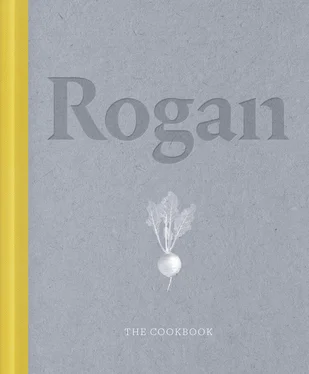To make the hyssop sauce, warm 2 tablespoons of the oil in a large, heavy-based saucepan over a medium heat and sweat the sliced shallots and fennel with the pinch of salt for 3–5 minutes, or until the shallots have become translucent. Deglaze the pan with the vinegar and white wine and reduce for about 3 minutes to a slightly thicker syrup consistency. Add the cream and 30ml water and bring to the boil, then reduce the heat and simmer for 5 minutes. Whisk in the butter gradually, a small piece at a time, to thicken the sauce. Remove from the heat and add the hyssop. Cover and leave to infuse for 30 minutes. Strain through a fine sieve and leave to one side.
Preheat the oven to 200°C/180°C Fan/Gas Mark 6. Remove any loose outer leaves from the cabbage to expose the heart, then cut the cabbage heart into quarters through the root. Warm the remaining 2 tablespoons of the oil in a large, ovenproof non-stick frying pan over a medium heat and colour both cut sides of the cabbage quarters until deeply golden, then finish the cooking in the oven for 10–12 minutes.
Shuck the oysters, keeping the juice and the meat separate. Pass the juice through a fine sieve into a small saucepan. Over a high heat, bring the oyster juice to the boil then immediately remove from the heat. Add the oysters and let them poach lightly for 30 seconds–1 minute in their own juices off the heat.
Deep-fry the pork skin in batches in a saucepan of oil heated to 180°C for about 1 minute until puffed and crisp like pork scratchings. Remove from the hot oil with a slotted spoon, leave to drain on kitchen paper and season them with salt.
Meanwhile, gently heat the hyssop sauce over a low heat to warm it through.
Fan the cabbage out on each plate, scatter the poached oysters and crispy pork on top, finish with the warm sauce and scatter over the hyssop flowers.
TORCHED MACKEREL WITH CHICORY MARMALADE AND TOASTED BARLEY SAUCE
Blowtorching is a simple but effective way of cooking fish; the flame comes into direct contact with the mackerel, giving it a smoky, charred flavour. Mackerel works really well with strong, slightly acidic flavours, so the bitter chicory and orange marmalade balanced with a touch of sugar is is the perfect partner. Barley is often limited to soups and risottos, but toasting the grains gives them a wonderful depth of flavour and nuttiness. In the past I have given rosemary a supporting role because I’ve felt there are other, more interesting herbs, but I’ve come to really appreciate its qualities and here its warm, peppery notes allow the flavours of the pine and nutmeg to develop.
SERVES 4, AS A STARTER
Toasted barley sauce
80g pearl barley, plus 25g cooked
375ml White Chicken Stock
4 sprigs of rosemary
125ml whole milk
1 soft-boiled egg (cooked for 4 minutes)
lemon juice, for seasoning
Torched mackerel
25g coriander seeds
25g fennel seeds
500g rock salt
250g caster sugar
zest of 1 lemon
4 fresh mackerel fillets, skin on
Chicory marmalade
1 tbsp sunflower oil
30g unsalted butter
600g chicory, thinly sliced
20g caster sugar
350ml orange juice
Maldon sea salt, for seasoning
land seaweed, to serve
Preheat the oven to 200°C/180°C Fan/Gas Mark 6.
For the sauce, toast the 80g pearl barley on a baking tray in the oven for 35–40 minutes until golden brown. Remove from the oven and leave to one side to cool. In a medium, heavy-based saucepan over a high heat, bring the chicken stock to the boil with the rosemary sprigs, then remove from the heat, add the toasted barley and allow to infuse for 1 hour.
Strain the barley from the stock and discard. Blitz the infused stock in a blender with the milk, egg and cooked barley until smooth, then pass through a fine sieve and season with lemon juice and salt.
For the mackerel, toast the coriander and fennel seeds in a dry non-stick frying pan over a medium heat for 4–5 minutes, then blitz them to a powder in a blender or grind them in a pestle and mortar. Combine the ground seeds in a bowl with the salt, sugar and lemon zest and mix well. Dust the mackerel fillets evenly on both sides with the salt mixture. Transfer to a plate and leave to cure in the fridge for 10 minutes. Rinse the fillets under cold running water and pat them dry with kitchen paper.
While the mackerel is curing, start the chicory marmalade. Preheat a medium heavy-based saucepan over a medium heat. Put the oil and butter in the saucepan with a pinch of salt, then add the chicory and sauté for 8–10 minutes until all the liquid has evaporated and the chicory is soft. Add the sugar and cook for a further 5 minutes to caramelise it, then add the orange juice, reduce the heat and reduce the liquid to a glaze.
Using a blowtorch, torch the skin side of the cured mackerel until lightly charred and smoky.
Spoon the warmed chicory marmalade on to the centre of each plate. Put the torched mackerel fillets on top and spoon the warmed sauce around. Finish with land seaweed and Maldon sea salt.
SALT COD MOUSSE, BLACK RADISH AND RAMSON SAUCE
In early spring, all around Cartmel ramsons fill the air with their distinctive garlicky aroma. The season is brief, so we like to make as much use of it as we can, such as in this vibrant and delicious green sauce. This recipe makes a good quantity of sauce, but any left over can be kept in the fridge, covered, for 3–5 days and used with any simple dishes, such as grilled lamb chops. You need to plan ahead with this dish – the fish needs curing for 1 hour and the mousse needs to set in the fridge for a minimum of 3 hours for perfect flavouring and consistency.
SERVES 6, AS A STARTER
Salt cod mousse
125g fresh cod fillet, skinned
15g fine salt
40g flat-leaf parsley leaves
50ml sunflower oil
2½ gelatine leaves
130g potatoes (preferably Maris Piper), peeled and cut into even-sized chunks
300g crème fraîche
Ramson sauce
250g ramson leaves
2 tbsp sunflower oil
2 medium shallots, thinly sliced
200ml whole milk
200ml double cream
Black radish
1 large black radish, or any other radish
4 tsp salmon roe
salt, for seasoning
tagetes leaves and flowers, to serve
Dust the cod fillets with the salt and place on a plate in the fridge to cure for 1 hour. Rinse off the salt under cold running water and pat the fillets dry with kitchen paper. Blitz the parsley and oil together in a blender until smooth, strain through muslin into a bowl and put to one side.
Preheat the oven to 170°C/150°C Fan/Gas Mark 3.
Soak the gelatine in cold water for a few minutes until softened. Drain, squeeze out the excess water and leave the gelatine to one side.
Cook the potatoes in a saucepan of water over a high heat until tender. Bake the cod fillets on a baking tray for 6–8 minutes until flaky.
Drain the potatoes and flake the cod, and blitz them together in a blender with the softened gelatine leaves until smooth. Press through a fine sieve and fold in the parsley oil and crème fraîche. Transfer to an airtight container and leave in the fridge for 3 hours to set.
To make the sauce, bring a large saucepan of water to the boil and blanch the ramsons for 2 minutes. Remove from the water with a slotted spoon and transfer to a bowl of iced water to stop it cooking. Drain and squeeze out the excess water. In a medium, heavy-based saucepan, heat the oil over a medium heat and sweat the sliced shallots for 3–5 minutes, or until translucent. Add the milk and cream and bring to the boil, reduce the heat and simmer until reduced by two-thirds. Pour into a blender, add the blanched ramson leaves and blitz until smooth, then strain through a fine sieve into a bowl, cover and chill.
Читать дальше












